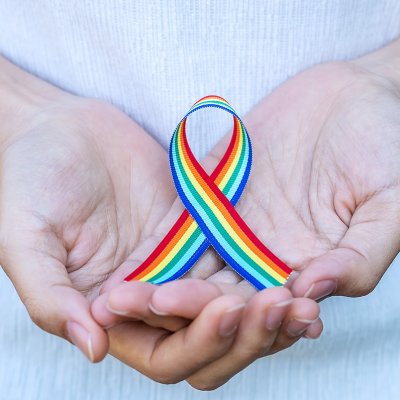You wouldn’t know I’m queer at first glance.
I’m your garden-variety, athletic-ish, 30-something white woman. Folks usually assume I’m straight, since I’m married to a man. But I’m not straight, and I’m not monogamous either. I identify as queer, and I feel most comfortable in environments that are explicitly queer friendly.
My dual identity–I’m the “provider” in the provider-patient relationship while I’m at work, but I’m the “queer patient” to my own healthcare providers–allows me to be included as an insider in both sides of the conversation. I often hear gender and sexual minority groups discussing the ways they continue to feel excluded in all sorts of settings, and I hear providers talking about how much they want to help LGBTQ folks feel included, but feel they don’t have the tools. I’m here to tell you: we can all acquire the tools to take great care of our queer patients through education and listening.
One afternoon, my coworkers and I were sitting in the therapists’ office when one warned another that the patient he was about to see was gay. Before she could finish what she was saying, he took the chart and said, with a knowing nod, “Oh, I had a gay roommate once. I know how they can be.” This type of language, grouping gay and straight people into “us” and “them,” as well as making assumptions about an individual based on their membership in a group, is the sort of micro-aggression we want to avoid as informed providers. At this moment in history, we have a tremendous opportunity to move past the “us vs. them” mentality and provide equitable and even excellent care for LGBTQ patients.
In my opinion, there are three steps to creating inclusive healthcare practices: creating inclusive procedures and documentation, educating providers, and working towards institutional culture change.
Many practices are actively working to be more queer-friendly. Procedures that take the continuum of sexual and gender identities into account are a part of “universal design;” in the same way that curb cuts in the sidewalk allow both wheelchair users and kids on bicycles to cross the street safely, open-ended pronoun, significant other, and family structure questions on intake forms allow LGBTQ folks to identify themselves in whatever terms they find most comfortable, rather than trying to fit into a drop-down menu or checkbox. Documentation and scheduling systems can be structured to allow pronouns and preferred names to follow the patient’s information throughout their healthcare encounter. This book is about workplace inclusion, but it’s a short and sweet guide that’s applicable to healthcare spaces as well.
Once we establish procedures that include queer folks, we can educate ourselves to elevate our practice into truly excellent care for LGBTQ populations. Queer folks still suffer disparities in health outcomes, and providers across disciplines have called for a person-centered approach to address the needs of these diverse individuals. For PTs, that means understanding the person in front of you in the context of the groups they belong to. We already do this with a range of patient populations. For example, we know our adolescent ballet dancer patients tend to have a hypermobile tissue type and are at higher risk of eating disorders than adolescents who don’t dance. We intuitively use this information to ask appropriate screening questions, tailor interventions, and assess the potential need for referral. Once you know that transgender adolescents are more likely to consider and attempt suicide than their cisgender counterparts, you might choose to screen your young transgender patient using a validated tool such as the PHQ-2. (Given that the Census Bureau measured in 2021 that 16.1% of non-LGBT adults and 38.2% reported feeling depressed on more than half of the days, perhaps we should be screening everyone?)
Experienced PTs know that a truly effective rehab environment requires trust between the provider and the patient. The better you understand the “queer experience,” the better you can relate to your queer patient. Every individual’s experience is different, but the more we know, the better we can contextualize each individual’s story. Only in 2015 were state bans on gay marriage struck down by the Supreme Court, and the legal, financial, and psychological consequences of not being allowed to marry continue to have lasting effects on same-sex couples. The experience of a gay or lesbian person as they navigate the complex legal environment may be different than your own, and understanding these differences gives you the tools to treat your patients with respect and compassion. And although lesbian, gay and bisexual individuals continue to be more likely to experience sexual violence than heterosexual people, your patient may not share a history of trauma with you if they don’t feel they can trust you. By showing that you care about each person’s story, you will facilitate disclosure so you can understand the unique psychosocial aspects of their care.
Transgender populations have specific medical and orthopedic considerations for rehab. Trans folks may be taking medications that affect their secondary sex characteristics, or have had gender-affirming surgery. We all know the importance of the pelvic floor in rehab–what if your patient has had a vaginoplasty and now experiences pain with pelvic floor muscle recruitment? How will you modify your abdominal strengthening exercises? What referrals might you provide? Excellent care requires an understanding of the transgender experience, surgical procedures and complications, and the individual in the context of these factors. Transgender people tend to be marginalized by society, and are more likely to be the victims of violence than cisgender people. With few exceptions, trans folks have felt excluded by the dominant culture at some point, and have experienced gender dysphoria. A trauma-informed approach, which takes into account an individual’s history of traumatic experiences during all aspects of their care, may improve rehab outcomes. Erin Maxwell, LCSW-C (they/them or he/him), a trans care navigator for gender-affirming surgery at Medstar Franklin Square Hospital, agrees, and challenges us to be empathetic and compassionate with our patients. “Trauma-informed care for trans folks includes recognition of how challenging examinations and handling of the body can be due to dysphoria, trauma, etc. How does a patient refer to parts of their body? Are they comfortable with being touched? Do they prefer to have someone in the room with them or have safety practices to mitigate nervous system activation during sessions that a provider should be aware of?”
The best way to provide excellent care for queer populations is to educate yourself. Read, take courses (see below), and go deeper. Institutional change takes time and is outside the scope of this post, but it starts with you. As clinicians, our services are the product that companies are selling. We are the face of our institutions in many ways. Be the change you want to see in your practice environment.
A few weeks after my colleague saw that gay patient, he came up on my schedule. We chatted as he warmed up on the bike, and he mentioned one of his friends who had passed away long ago. I expressed my sympathy. With a shrug, he said, “Most of my friends are dead.” I blinked, racing to figure out what he was talking about. This was a 65-year-old gay man. Of course; he had lived through the AIDS epidemic. He watched as his friends and partners, young men at the time, died one after the other. By understanding his experience, I deepened my understanding of him as a patient and as a person.
It doesn't take personal experience to have an informed practice model for your queer patients. I'm not trans, and I'll never have experience living as a gay man. But by reading, listening, and discussing the relevant issues, we can provide better care for queer patients every day. Being informed is simple, but it's not easy. Start by inspecting your assumptions and examining your biases. You won’t get it right every time, but asking, “Am I using the right name for you? Did the receptionist ask you your pronouns?” shows that you care, even though you’re not perfect.
*I use the acronym LGBTQ here to represent the entire spectrum of gender and sexual orientation identities. This acronym has many forms, including more comprehensive versions such as LGBTQQIIAP2SAA+, and as language evolves, inclusive terms will continue to evolve as well. I have selected LGBTQ as a widely accepted and familiar version, but it is intended to include all identities denoted in the LGBTQQIIAP2SAA+ acronym.
Additional Readings
Article:
Kroning, Maureen EdD, MSN, RN; Listopad, Katerina MSN, ANP-C, CCRN. Gender confirmation surgery: Critical considerations. Nursing Critical Care: March 2018 - Volume 13 - Issue 2 - p 32-37. (Free full text)
Winter S, Diamond M, Green J, Karasic D, Reed T, Whittle S, Wylie K. Transgender people: health at the margins of society. Lancet. 2016 Jul 23;388(10042):390-400. (free full text)
Book:
Gender Diversity and Non-Binary Inclusion in the Workplace, by Sarah Gibson.
Further CEU Education Courses:
1.5 hour APTA Learning Center course on Transgender issues in PT: https://learningcenter.apta.org/student/mycourse.aspx?id=3e964c69-bc9e-4211-8fa7-1aeef3009101
15 hour course on Gender and Sexual Minority Care in PT: https://hermanwallace.com/continuing-education-courses/inclusive-care-for-gender-and-sexual-minorities (offered periodically)
References
- Arcelus J, Witcomb GL, Mitchell A. Prevalence of eating disorders amongst dancers: a systemic review and meta-analysis. Eur Eat Disord Rev. 2014 Mar;22(2):92-101. doi: 10.1002/erv.2271. Epub 2013 Nov 26.
- Champine RB, Lang JM, Nelson AM, Hanson RF, Tebes JK. Systems measures of a trauma-informed approach: a systematic review. Am J Community Psychol. 2019 Dec;64(3-4):418-437. doi: 10.1002/ajcp.12388.
- McEwing E, Black T, Zolobczuk J, Dursun U. Moving beyond the LGBTQIA+ acronym: toward patient-centered care. Rehabil Nurs. 2022 Sep-Oct 01;47(5):162-167. doi: 10.1097/RNJ.0000000000000378.
- Messinger AM, Sessarego SN, Edwards KM, Banyard VL. Bidirectional IPV among adolescent sexual minorities. J Interpers Violence. 2021 Jun;36(11-12):NP5643-NP5662. doi: 10.1177/0886260518807218.
- Thoma BC, Salk RH, Choukas-Bradley S, Goldstein TR, Levine MD, Marshal MP. Suicidality disparities between transgender and cisgender adolescents. Pediatrics. 2019 Nov;144(5):e20191183. doi: 10.1542/peds.2019-1183.
- Winter S, Diamond M, Green J, Karasic D, Reed T, Whittle S, Wylie K. Transgender people: health at the margins of society. Lancet. 2016 Jul 23;388(10042):390-400. doi: 10.1016/S0140-6736(16)00683-8.
Author Bio:
Lizzie Cavanaugh Bellinger, PT, DPT is a Board-Certified Orthopedic Clinical Specialist and Certified Orthopedic Manual Therapist practicing in Maryland. She is in the process of opening a private practice specializing in orthopedics with a focus on inclusive care for gender and sexual minority populations. To keep busy, she teaches as an adjunct in the Doctor of Physical Therapy program at the University of Maryland School of Medicine and teaches kids to rock climb at the local climbing gym. Helping other people understand the world around them is her greatest joy.

